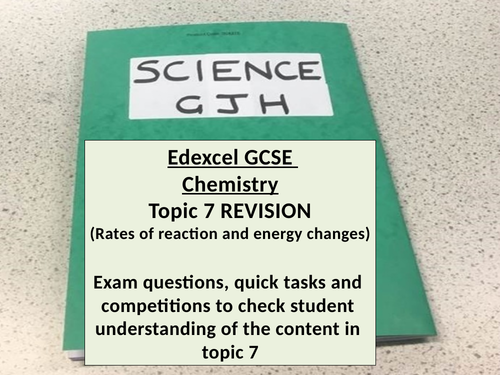




This is an engaging revision lesson which uses a range of exam questions, understanding checks, quick tasks and quiz competitions to enable students to assess their understanding of the content within topic 7 (Rates of reaction and energy changes) of the Edexcel GCSE Chemistry specification.
The specification points that are covered in this revision lesson include:
- Suggest practical methods for determining the rate of a given reaction
- Explain how reactions occur when particles collide and that rates of reaction are increased when the frequency and/or energy of collisions is increased
- Explain the effects on rates of reaction of changes in temperature, concentration, surface area to volume ratio of a solid and pressure (on reactions involving gases) in terms of frequency and/or energy of collisions between particles
- Describe a catalyst as a substance that speeds up the rate of a reaction without altering the products of the reaction, being itself unchanged chemically and in mass at the end of the reaction
- Explain how the addition of a catalyst increases the rate of a reaction in terms of activation energy
- Describe an exothermic change or reaction as one in which heat energy is given out
- Describe an endothermic change or reaction as one in which heat energy is taken in
- Recall that the breaking of bonds is endothermic and the making of bonds is exothermic
- Recall that the overall heat energy change for a reaction is: a exothermic if more heat energy is released in forming bonds in the products than is required in breaking bonds in the reactants b endothermic if less heat energy is released in forming bonds in the products than is required in breaking bonds in the reactants
- Calculate the energy change in a reaction given the energies of bonds (in kJ mol–1)
- Explain the term activation energy
- Draw and label reaction profiles for endothermic and exothermic reactions, identifying activation energy
The students will thoroughly enjoy the range of activities, which includes a quiz competition called “E NUMBERS” where they have to recognise the differences between endothermic and exothermic reactions whilst crucially being able to recognise the areas of this topic which need their further attention. This lesson can be used as revision resource at the end of the topic or in the lead up to mocks or the actual GCSE exams
Get this resource as part of a bundle and save up to 36%
A bundle is a package of resources grouped together to teach a particular topic, or a series of lessons, in one place.
Edexcel GCSE Chemistry REVISION LESSONS
This bundle of 7 revision lessons covers the content in the following topics of the Edexcel GCSE Chemistry specification Topic 1: Key concepts in Chemistry Topic 3: Chemical changes Topic 5: Separate chemistry 1 Topic 6: Groups in the Periodic Table Topic 7: Rates of reaction and energy changes Topic 8: Fuels and Earth Science Topic 9: Separate Chemistry 2 These lessons use a range of activities which include exam questions with fully explained answers, differentiated tasks and engaging quiz competitions to enable the students to assess their understanding of the different topics and crucially to recognise those areas which need further attention.
Edexcel GCSE Chemistry Paper 2 REVISION LESSONS
This bundle of 5 revision lessons covers the content which is found in Topics 1, 6, 7, 8 and 9 of the Edexcel GCSE Chemistry specification and therefore can be assessed on Paper 2 in the terminal exams. Topic 1: Key concepts in Chemistry Topic 6: Groups in the Periodic Table Topic 7: Rates of reaction and energy changes Topic 8: Fuels and Earth Science Topic 9: Separate Chemistry The lessons uses a range of activities which include exam questions with fully explained answers, differentiated tasks and engaging quiz competitions to enable the students to assess their understanding of the different topics and crucially to recognise those areas which need further attention.
Something went wrong, please try again later.
This resource hasn't been reviewed yet
To ensure quality for our reviews, only customers who have purchased this resource can review it
Report this resourceto let us know if it violates our terms and conditions.
Our customer service team will review your report and will be in touch.